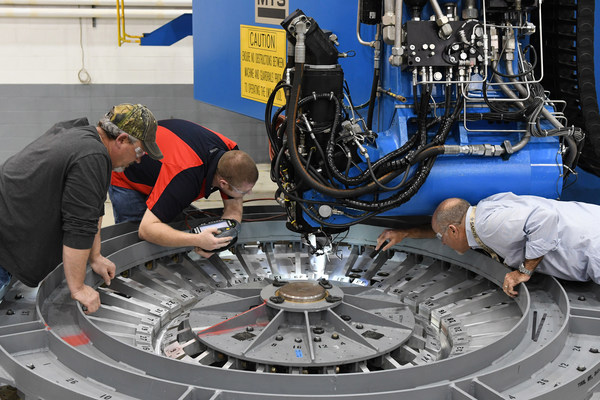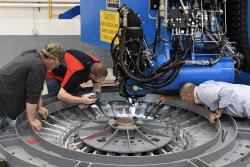Releases
DENVER, Feb. 1, 2018 /PRNewswire/ -- Construction has officially begun on the spaceship that will achieve America's goal of returning astronauts to the Moon. Lockheed Martin (NYSE: LMT) technicians and engineers at the NASA Michoud Assembly Facility near New Orleans welded together the first two components of the Orion crew module capsule for Exploration Mission-2 (EM-2).
Orion is America's exploration spaceship, and the EM-2 mission will be its first flight with astronauts on board, taking them farther into the solar system than ever before. This flight, launched atop the Space Launch System (SLS) rocket, will usher in a new era of space exploration, laying the groundwork for NASA's lunar Deep Space Gateway, and ultimately for human missions to Mars.
"Orion has tremendous momentum. We're finishing assembly of the EM-1 Orion spacecraft in Florida, and simultaneously starting production on the first one that will carry crew," said Mike Hawes, Lockheed Martin vice president and program manager for Orion. "This is not only the most advanced spacecraft ever built, its production will be more efficient than any previous capsule. For example, look at the progress we've made on the EM-2 pressure vessel compared to the first one we built. The latest version is 30 percent lighter and has 80 percent fewer parts. That equates to a substantially more cost-effective and capable spacecraft."
Designed specifically to withstand the harsh and demanding environment of deep space travel while keeping the crew safe and productive, the main structure of the crew module, or pressure vessel, is comprised of seven large machined aluminum alloy pieces that are welded together to produce a strong, yet light-weight, air-tight capsule. The first weld joined the forward bulkhead with the tunnel section to create the top of the spacecraft.
The pressure vessel capsule will continue to be built out over the spring and summer in Michoud incorporating the three cone panels, the large barrel and the aft bulkhead. Once completed in September, it will be shipped to the Kennedy Space Center where the Lockheed Martin team will perform assembly and test of the EM-2 spacecraft.
"The EM-1 and EM-2 crew modules are very similar in design, but we've made a lot of improvements since we built EM-1, including processes, scheduling, and supply chain, all contributing to a lower cost and faster manufacturing," said Paul Anderson, director of Orion EM-2 production at Lockheed Martin.
But the historical importance of this Orion mission isn't lost to Anderson and his team. "Each of these spacecraft are important, but we realize that the EM-2 capsule is special as it's the first one to carry astronauts back out to the Moon, something we haven't done in a long time. It's something we think about every day."
About Lockheed Martin
Headquartered in Bethesda, Maryland, Lockheed Martin is a global security and aerospace company that employs approximately 100,000 people worldwide and is principally engaged in the research, design, development, manufacture, integration and sustainment of advanced technology systems, products and services.
SOURCE Lockheed Martin



